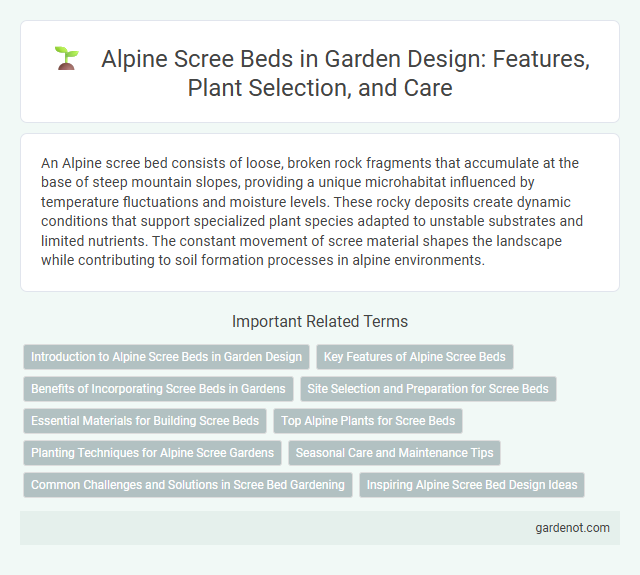An Alpine scree bed consists of loose, broken rock fragments that accumulate at the base of steep mountain slopes, providing a unique microhabitat influenced by temperature fluctuations and moisture levels. These rocky deposits create dynamic conditions that support specialized plant species adapted to unstable substrates and limited nutrients. The constant movement of scree material shapes the landscape while contributing to soil formation processes in alpine environments.
Introduction to Alpine Scree Beds in Garden Design
Alpine scree beds replicate natural mountain environments by incorporating loose, rocky substrates and drought-tolerant alpine plants like Saxifraga and Sedum. These gardens enhance drainage and create microhabitats ideal for specialized flora adapted to harsh, nutrient-poor conditions. Integrating alpine scree beds in garden design promotes biodiversity and adds textural contrast through rugged stone arrangements combined with resilient, low-growing vegetation.
Key Features of Alpine Scree Beds
Alpine scree beds consist of loose, fragmented rock debris deposited on steep mountain slopes, forming unstable yet dynamic habitats. These scree environments feature rapid drainage, high exposure to wind and temperature fluctuations, and limited soil development, which influence the specialized flora and fauna adapted to extreme conditions. The constant rockfall and shifting substrate create unique ecological niches, supporting pioneer plant species and invertebrates capable of surviving in nutrient-poor, unstable terrain.
Benefits of Incorporating Scree Beds in Gardens
Alpine scree beds enhance garden biodiversity by providing microhabitats suited for drought-tolerant and rock-loving plants, such as saxifrages and sedums. Their well-drained, rocky substrate promotes healthy root growth and reduces waterlogging, making them ideal for sustainable gardening in temperate climates. Incorporating scree beds also improves soil aeration and supports pollinators, contributing to a resilient and visually appealing garden ecosystem.
Site Selection and Preparation for Scree Beds
Effective site selection for Alpine scree beds hinges on identifying well-drained, rocky slopes with natural scree deposits to ensure proper water runoff and root aeration. Preparing the site involves clearing existing vegetation, removing fine soil particles, and mimicking natural scree conditions by placing angular stones of varying sizes to facilitate drainage and microhabitat diversity. Optimal elevation and exposure to sunlight are critical factors to replicate the native alpine environment, promoting successful establishment and growth of scree-adapted plant species.
Essential Materials for Building Scree Beds
Alpine scree beds require well-drained, coarse materials such as fragmented limestone, granite, or quartzite to replicate natural mountainous conditions. Incorporating angular stones of varying sizes ensures proper aeration and water runoff, promoting root health for scree-adapted plants. Essential materials also include grit, sand, and mineral-rich soil to provide stability and essential nutrients in this specialized alpine environment.
Top Alpine Plants for Scree Beds
Top alpine plants for scree beds include Androsace, Saxifraga, and Draba species, which thrive in well-drained, rocky soils with minimal organic matter. These plants exhibit adaptations such as cushion-shaped growth and deep root systems to withstand harsh alpine conditions and temperature fluctuations. Choosing native alpine flora like Edelweiss (Leontopodium alpinum) and Alpine Forget-me-not (Myosotis alpestris) enhances biodiversity and ensures ecological compatibility in scree bed landscaping.
Planting Techniques for Alpine Scree Gardens
Planting techniques for Alpine scree gardens emphasize selecting drought-tolerant, well-drained soil species such as Saxifraga, Sedum, and Draba, which thrive in rocky, nutrient-poor conditions. Creating a scree bed requires layering coarse grit and gravel to mimic natural alpine environments, promoting root aeration and preventing waterlogging. Strategic placement of plants in crevices and raised mounds simulates natural growth patterns, enhancing survival rates and overall garden aesthetics.
Seasonal Care and Maintenance Tips
Alpine scree beds require seasonal care to maintain optimal drainage and plant health, especially during spring thaw and autumn leaf fall. Clearing debris and ensuring proper rock placement prevents waterlogging and root rot in fragile alpine plants. Regularly monitoring soil moisture and removing invasive species supports a thriving, resilient alpine scree environment.
Common Challenges and Solutions in Scree Bed Gardening
Alpine scree beds pose common challenges such as poor soil retention, rapid drainage, and vulnerability to erosion, which hinder plant establishment and growth. Solutions include incorporating coarse gravel or sand to improve soil structure, using windbreaks or rock arrangements to reduce erosion, and selecting drought-tolerant, root-adapted species native to alpine environments. Proper site drainage and regular monitoring help maintain optimal moisture levels and prevent waterlogging or desiccation in scree bed gardening.
Inspiring Alpine Scree Bed Design Ideas
Alpine scree beds combine rugged natural rock fragments with hardy alpine plants, creating a dynamic and low-maintenance garden feature that mimics mountainous terrain. Incorporating diverse textures and colors such as gray slate, granite, and weathered limestone alongside drought-tolerant species like sedums, saxifrages, and alpine asters enhances visual interest while promoting ecological resilience. Strategic stone placement and varying plant heights optimize drainage and microclimates, inspiring innovative designs that blend functionality with striking alpine aesthetics.
Alpine scree bed Infographic

 gardenot.com
gardenot.com